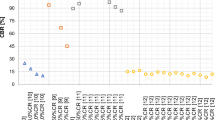Abstract
Purpose
The use of carbon fiber-reinforced polymer matrix composites is gaining momentum with the pressure to lightweight vehicles; however energy intensity and cost remain major barriers to the wide-scale adoption of this material for automotive applications. This study determines the relative life cycle benefits of two precursor types (conventional textile-type acrylic fibers and renewable-based lignin), part manufacturing technologies (conventional SMC and P4), and a fiber recycling technology.
Materials and methods
A representative automotive part, i.e., a 30.8-kg steel floor pan having a 17% weight reduction potential with stringent crash performance requirements, has been considered for the life cycle energy and emissions analysis. Four scenarios—combinations of the precursor types and manufacturing technologies—are compared to the stamped steel baseline part.
Results and discussion
The analysis finds the lignin-based part made through P4 technology to offer the greatest life cycle energy and CO2 emissions benefits. Carbon fiber production is estimated to be about 14 times more energy-intensive than conventional steel production; however, life cycle primary energy use is estimated to be quite similar to the conventional part, i.e., 18,500 MJ/part, especially when considering the uncertainty in LCI data that exist from using numerous sources in the literature.
Conclusions
The sensitivity analysis concludes that with a 20% reduction in energy use in the conversion of lignin to carbon fiber and no energy use incurred in lignin production since lignin is a by-product of ethanol and paper production, a 30% reduction in life cycle energy use could be obtained. A similar level of life cycle energy savings could also be obtained with a higher part weight reduction potential of 43%.









Similar content being viewed by others
References
Allred RE (2005) Carbon-reinforced composite recycling: process and business development. Presented at Global Outlook for Carbon Fibers 2005, Intertech Conferences, San Diego, CA
Arato C, Pye K, Gjennestad G (2004) The lignol approach to biorefining of woody biomass to produce ethanol and chemicals. Presented at the 26th Symposium on Biotechnology for Fuels and Chemicals, Chattanooga, TN
Baker FS, Gallego NC, Naskar AK, Baker DA (2008) Low-cost carbon fibers from renewable sources: In FY2007 Progress Report: Automotive Lightweighting Materials, US Department of Energy, Washington, DC
Brown HL, Hamel BB, Hedman BA, Koluch M, Gajanana BC, Troy P (1996) Energy analysis of 108 industrial processes. Fairmont, Liburn
Cunliffe AM, Nicola J, Williams PT (2003) Recycling of fiber-reinforced polymeric waste by pyrolysis: thermo-gravimetric and bench-scale investigations. J Anal Appl Pyrol 20:315–338
Font R, Esperanza M, Garica AN (2003) Toxic by-products from the combustion of Kraft Lignin. Chemosphere 52:1047–1058
Ibis Associates, Inc. (Ibis) (2007). Results review: Technical cost model development for structural composite underbody. Presentation made to the ACC Composite Underbody Program, Waltham, Massachusetts, Nov. 25
Jody BJ, Pomykala JA Jr, Daniels EJ, Greminger JL (2004) A process to recover carbon fibers from polymer-matrix composites in end-of-life vehicles. J Met 56(8):43–47
Koltun A et al (2005) An approach to treatment of recycling in LCA. Paper presented at the 4th Australian LCA Conference. Sydney, Australia, Feb
Murphy T (2008) The new face of CAFÉ. Ward’s Autoworld February:36–40
SimaPro (2008). SimaPro 7.1.7 LCA software. Pre Consultants, The Netherlands, http://www.pre.nl/simapro/default.htm
Sullivan J, Hu J (1995) Life cycle energy analysis for automobiles. SAE paper No. 951829, Society of Automotive Engineers, Warrendale, PA
Sullivan JL Williams RL, Yester S, Cobas-Flores E, Chubbs ST, Hentges SG and Pomper SD (1998) Life cycle inventory of a generic US family sedan: Overview of results USCAR AMP project. SAE Paper No. 982160, Society of Automotive Engineers, Warrendale, PA
Suzuki T, Takahashi J (2005) Prediction of energy intensity of carbon fiber reinforced plastics for mass produced passenger cars, Proceedings of 9th Japan International SAMPE Symposium, pp 14–19
Suzuki T, Odai T, Hukui R, Takahashi J (ND) LCA of passenger vehicles lightened by recyclable carbon fiber reinforced plastics. http://sunshine.naoe.t.u-tokyo.ac.jp. Accessed 9 September 2008
US Department of Energy (DOE) (2008) Automotive composites consortium focal project 4. Automotive Lightweighting Materials: FY 2007 Progress Report, Washington, DC
Wang MQ (2008) GREET 1.8b: The greenhouse gases, regulated emissions, and energy use in transportation (GREET) model. Center for Transportation Research, Argonne National Laboratory, Argonne, IL, Mar. 17
Author information
Authors and Affiliations
Corresponding author
Additional information
This work was conducted by the author at Oak Ridge National Laboratory, managed and operated by UT-Batelle, LLC, for the US Department of Energy under contract No. DE-AC05-00OR22725.
Rights and permissions
About this article
Cite this article
Das, S. Life cycle assessment of carbon fiber-reinforced polymer composites. Int J Life Cycle Assess 16, 268–282 (2011). https://doi.org/10.1007/s11367-011-0264-z
Received:
Accepted:
Published:
Issue Date:
DOI: https://doi.org/10.1007/s11367-011-0264-z




